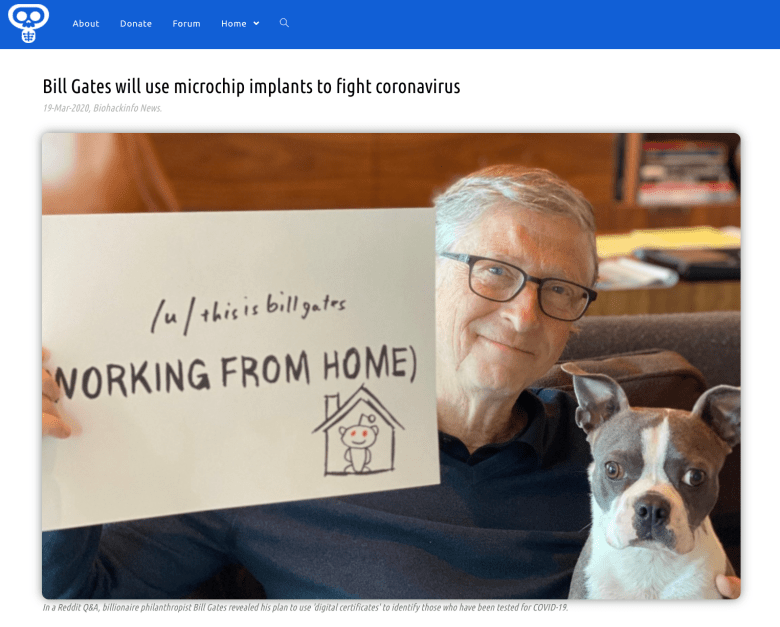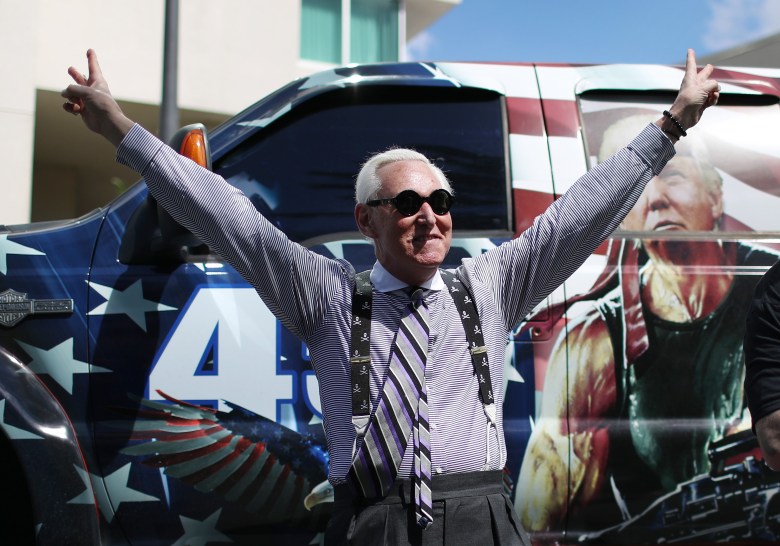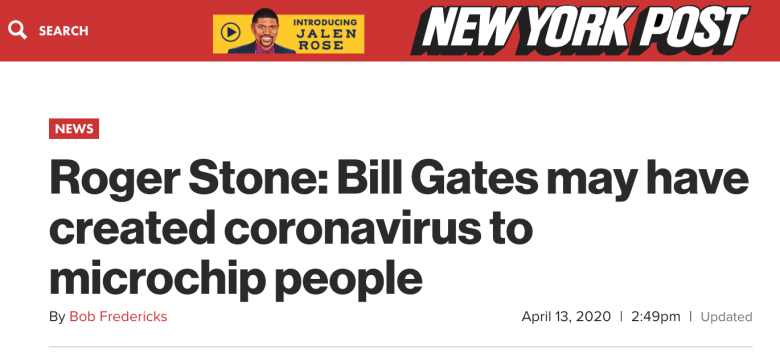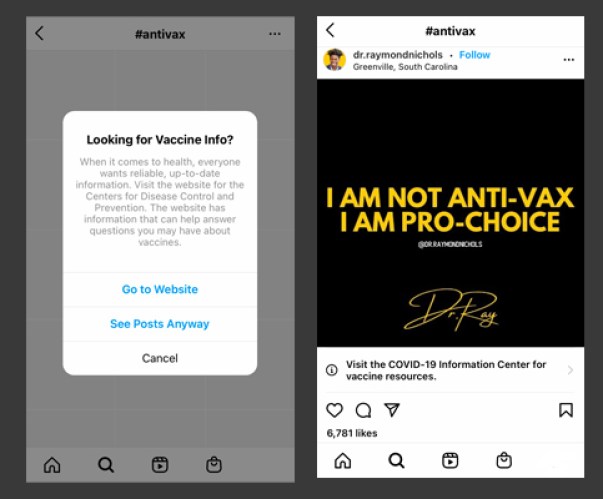Where did the microchip vaccine conspiracy theory come from anyway? – Reveal
This article was published in partnership with The Verge.
On Oct. 2, 2020, President Donald Trump and the first lady tested positive for the coronavirus. As we were all waking up to the news, I got into my car and tuned in to “The Breakfast Club” on Power 105.1 FM in New York, where Charlamagne Tha God, its most outspoken host, wasn’t having it. “I got a few thoughts, and one of those thoughts is the reason I’m saying ‘allegedly,’ ” he said.
At the time, the country was accelerating into the third wave of the pandemic, and the president had been appearing at large maskless rallies. But the news didn’t sit right with Charlamagne. “The conspiracy theorist in me simply doesn’t believe it,” he said.
As I listened, he seemed to build a conspiracy theory on the fly. According to Charlamagne, the president was pretending to get the coronavirus so he could be the first to take the vaccine and become a hero to the world just in time for the election. Which is the provocative, Sasquatch-exists brand of conspiracy theory you might expect to hear on the show. But then Charlamagne took the conversation in a direction I didn’t see coming: “Millions will line up to take the vaccine, and boom, microchips for all of y’all, right in time for goddamn Thanksgiving.”
Microchips? In the vaccine? I looked around to see if I could make eye contact with any neighbors. Did anyone else hear that? I thought. But no one else was shaking their head at their radios. Hopefully, the millions who tune in to this nationally syndicated show knew he was just joking. Right? But after the fourth time Charlamagne repeated his wild claim that the government is putting microchips in the COVID-19 vaccine, I couldn’t help but wonder: Is this going to be a problem?
To be clear: There are no microchips in any vaccine. There’s no evidence that even one of the nearly 170 million Americans who have received a shot so far have been implanted with a tiny piece of tracking hardware.
But this conspiracy, along with other false claims about the vaccine, has gained traction. These dangerous myths have built on a distrust of vaccines sown for years by well-organized groups that launched targeted, effective disinformation campaigns. Through glossy magazines distributed to Orthodox Jews in New York, intimate seminars led by Robert F. Kennedy Jr. on the California coast and deceptive websites like the National Vaccine Information Center, these messages found receptive audiences among Americans who have grown more distrustful of its elites and institutions.
Even before COVID-19, anti-vaccine disinformation has had real consequences for our health. Measles, which was controlled in the 20th century, is back in the 21st. One of the key reasons, according to Dr. Seth Berkley, CEO of the nonprofit Gavi, the Vaccine Alliance: “the spread of falsehoods about the vaccine.” The World Health Organization now ranks vaccine hesitancy as one of the top 10 threats to global health.
In the U.S., polling from March found that 42% of respondents believed at least one COVID-19 conspiracy theory. That survey, commissioned by the nonprofit Surgo Ventures, found that 16% of eligible Americans are a hardened group of COVID-19 skeptics steeped in conspiracy theories, while another 7% are system distrusters. The skeptics are disproportionately White and conservative, while the system distrusters are heavily Black and Latinx. This mixture of ideological strains means vaccine hesitancy has taken hold in rural communities and religious enclaves, in dense coastal cities and in wine country. As the nation moves into a phase when most vaccine enthusiasts have gotten their shots, this broad coalition of the skeptical poses a massive challenge for public health officials. The next phase of vaccination will likely depend on reaching members of this population and understanding their specific concerns.
Dr. Jordan Dow works at Kings County, a large public hospital in Brooklyn, about a mile from where I heard the microchip rumor. He said he was hearing a variant on the microchip conspiracy in his ER. Dow said that of the hundreds of patients he was giving COVID-19 nasal tests to every day, 1 in 5 would ask about a tracking microchip on the end of the swab. “I would just look at them like, ‘This is not the time to play,’ ” he told me.
Most would laugh and go on with the test; others would refuse. The Surgo survey found that 1 in 14 people believe a tracking chip might be planted with the vaccine. A poll from Axios/Ipsos, also from March, asked 1,000 American adults if the COVID-19 vaccines contained a tracking microchip. More than 1 in 4 said they didn’t know. That’s the equivalent of nearly 69 million people.
Joan Donovan, research director of the Shorenstein Center on Media, Politics and Public Policy at Harvard, is the kind of disinformation researcher who listens to White supremacist podcasts at 2 a.m. That’s actually how she first learned about a mysterious illness in China before she had seen news of the outbreak published anywhere else.
“I don’t think anybody’s written a definitive case on the microchips,” she said, “but I have one kind of half-done that might be useful for you.”
Donovan’s analysis led me to some web chatter at the dawn of the U.S. pandemic, on March 18, 2020 – after the NBA had suspended its season but when reported American deaths were still around 150. That’s when Bill Gates, whose foundation has pledged $1.75 billion toward international pandemic aid, logged onto a Reddit AMA to answer questions about the pandemic. In the chat, he predicted that one day, we would all carry a digital passport for our health records. He suggested not a microchip, but some kind of e-vaccine card that people could flash before going into a business.
The next day, a Swedish website that reads like a tabloid full of memes about biohacking wrote about Gates’ comment. The site’s administrator, who goes by the name CyphR, belongs to a community of biohackers who advocate for human implantable microchips. They also have them – and hope that one day we all will be using them to monitor our biometrics and verify our identity. But they believed that future was a decade away.
That is until they saw Gates’ comment about digital certificates on Reddit. “We’re like, WTF! This is it! Suddenly, chip implants don’t only have an actual, scalable mainstream application, but one that is an urgent medical need,” CyphR said in an email. The bloggers connected Gates’ remark with various research projects supported by the Bill & Melinda Gates Foundation, including one December 2019 study exploring invisible “quantum dot” tattoos that could reveal your vaccine history when held close to a special smartphone light.
Then, CyphR acknowledged, they made a fateful “jump” – by suggesting the best way to implement Gates’ idea was through an implantable microchip. “(W)e did what do best and tried to meme this biohack into the mainstream,” CyphR wrote. “(A)s advocates of biohacking, that’s what we do. We advocate for the adoption of biohacking wherever possible, even if it means memeing the desired outcome.”
Their headline read: “Bill Gates will use microchip implants to fight coronavirus.”

Two days later, Adam Fannin, a polemical Baptist pastor from Jacksonville, Florida, stumbled upon the blog post online. It resonated with his deep distrust of Gates and he ran with it. Fannin, who started his own church with its own YouTube channel in 2017, transformed the biohackers’ fantasy into a biblical prophecy, one that was warned about in the Book of Revelation: “It’s not just an implantable ID system,” Fannin says on a YouTube video. “It’s literally worshipping this beast.”
The pastor’s 9-minute sermon tapped into a long-standing, wide-ranging conspiracy theory that Gates, through his business and philanthropy, is trying to “depopulate” the planet. The pastor titled the post, “Bill Gates – Microchip Vaccine Implants to fight Coronavirus,” adding one pivotal word to the biohackers’ title: vaccine.
The video quickly got 1.6 million views – an order of magnitude more than the pastor’s account had ever received.
Then the conspiracy theory spread. Posts like this were suddenly getting shared by shock-jock comedians and doomsday preppers on YouTube; by the far-right news site Newsmax; by pop culture icons such as M.I.A. and Kanye West; and by defiant, conspiracy-minded members of Gen Z on TikTok. In one minute-long video, a young woman points at spurious microchip-related screengrabs and over an “X-Files”–style score says, “It’s already being activated across the globe, including New York.”
Each time I saw a new host repeat the lie, it seemed to mutate, tapping into a new strain of American mistrust: mistrust of the medical system, mistrust of the government, mistrust of powerful elites. And then there’s Roger Stone.

On April 13, 2020, in Stone, the lie found the superspreader it had been waiting for. That’s when the former political adviser to Trump, who was convicted of repeatedly lying to Congress, made a guest appearance on “The Joe Piscopo Show” on AM 970 in New York.
The early “SNL” star didn’t even need to prompt Stone before he launched in. “Whether Bill Gates played some role in the creation and spread of this virus is open for vigorous debate,” Stone said. “He and other globalists are definitely using it in a drive for mandatory vaccinations and microchipping people.”
Later that afternoon, the New York Post gave the story legitimacy, running the headline, “Roger Stone: Bill Gates may have created coronavirus to microchip people.”

Soon, the Post story and the pastor’s video each had over a million interactions on Facebook. Since then, the lie has continued spreading and mutating across the world. By January, according to the Surgo survey, 1 in 10 U.S. adults – and 1 in 7 Republicans – said they believed a tracking chip would be implanted with the vaccine.
Charlamagne and the Post did not respond to queries about their role in spreading the conspiracy, and Reddit spokesperson Sierra Gamelgaard claimed the conspiracy had existed in the bowels of the web – on 4plebs – before it surfaced on Reddit.
But Fannin and Stone defended their remarks. “The idea of a microchip in order to track who has been vaccinated is no crazier than the idea of a vaccine passport,” Stone said. “The first amendment of the U.S. Constitution gives every American the right to question the safety of any vaccination.” Fannin, the YouTube preacher, confirmed his view that “Bill Gates is an evil person” – and that he has continued to avoid the vaccine himself.
It’s easy to write off these beliefs as far-fetched. But since I started looking closely at this conspiracy theory, I started seeing microchips everywhere. One night, I turned on “60 Minutes” and saw a segment about how the U.S. military is developing a subdermal implantable sensor to detect viruses. But it’s not a tracking microchip, right? Then a couple of weeks later, the show was reporting on an international microchip shortage. Where’d they all go? Then IBM announced that the company had designed the smallest, most powerful microchip ever. It felt like I was consuming the raw material that would shape the next microchip conspiracy theory.
Social media is the place where so much information gets repackaged and shared as misinformation. So I went to the major platforms to ask what they are doing to contain this high-stakes infodemic. Facebook, which also owns Instagram, said that by May, the platform had removed 16 million pieces of content for violating its COVID-19 and vaccine misinformation policy and slapped warning labels on 167 million pieces of content rated false by its fact-checking partners.
YouTube offered a statement saying the platform had removed 900,000 misleading videos about the coronavirus, including 30,000 just about the vaccines. The video platform even has an explicit policy banning videos that claim there are microchips in the vaccine.
TikTok pointed to a policy that prohibits medical misinformation, including vaccine misinformation. But according to research by the nonprofit Center for Countering Digital Hate, based in London and Washington, platforms fail to act on 95% of COVID-19 and vaccine misinformation reported to them. That means that when people go looking for accurate information about the vaccine, there’s a decent chance they will run into a falsehood first.

In April, the video by the Baptist pastor that helped spark this conspiracy was still up, with nearly 2 million views. I asked YouTube why, but officials declined to answer. Instead, two days later – more than a year after the pastor shared it, spawning a wave of social media disinformation – YouTube decided to take the video down for violating its medical misinformation guidelines.
In total, the platform removed six out of seven YouTube videos I asked about. The comedian Andrew Schulz – who said, “So if you think that there’s not going to be more shit in that chip that they’re going to put in our arm besides proof that we’ve been vaccinated, you’re outta your goddamn mind” – got to stay.
TikTok likewise removed five of the six videos I asked about and quarantined the other one to limit its spread.
Given the scale of this problem and the severity of the public health risks it poses, I figured there’d be a war room of epidemiologists and disinformation specialists somewhere in the federal government poring over posts, monitoring conspiracies and coordinating with social media platforms and media outlets to halt their spread. Instead, Facebook, for instance, said the platform uses machine learning and human fact checkers to moderate posts to flag misinformation after it lives on the site.
In January, a year after the first U.S. case was reported, the White House released a national COVID-19 response plan that included building the “capacity to quickly identify disinformation.” But when I repeatedly asked the Centers for Disease Control and Prevention what resources it has deployed to tracking and responding to that misinformation, I couldn’t get an answer. I spoke with a member of the White House’s COVID-19 Health Equity Task Force, Bobby Watts, who is also CEO of the National Health Care for the Homeless Council. He told me about the federal government’s strategy to tackle vaccine hesitancy “with a mass education campaign to let people know about the importance of vaccinations,” including messages tailored to various Asian American and Pacific Islander cultures, Spanish speakers, people experiencing homelessness and rural Republicans. But he didn’t know whether the federal government has a way of monitoring and interrupting misinformation influencing those communities.
After weeks of asking the CDC and the White House to provide details on how they are monitoring COVID-19 misinformation, I finally turned to Joe Smyser, a public health expert whose nonprofit helped create the nation’s largest vaccine misinformation tracking system. Project VCTR (pronounced “vector”) is now used by 450 organizations, including the health department for New York City, the city whose radio and print outlets were so decisive in the early spread of the microchip conspiracy theory. Smyser said he has been talking with a team of data scientists at the CDC who just last year started to build their own misinformation monitoring system. But he said they had to proceed with caution – and were constrained from communicating with state health departments – because misinformation was so politicized in the last administration. The CDC did not respond to queries.
Tracking medical misinformation is a relatively new and underfunded field of public health. Of the flood of money dedicated to coronavirus vaccine research, production and distribution since the pandemic began, Smyser said, “less than one-half of 1% of global funding has gone to any research or any programs addressing misinformation.” The nonprofit CDC Foundation, he pointed out, recently put out a request for proposals for combating misinformation through social media; three to four projects will receive around $2 million each.
Meanwhile, the disinvestment has left county and state health departments mostly on their own, fighting the tide of COVID-19 misinformation while trying to get enough vaccines in enough arms to finally bring an end to the pandemic. With the nation’s current anemic response to misinformation, a new projection from the Surgo survey estimates that only 58% of the U.S. population, including 74% of adults, will be vaccinated by next April.
In New York, where the microchip theory first went mainstream, the city has a team that tracks vaccine rumors in order to inform its educational messaging. I recently found my way to the State Department of Health webpage dedicated to combating vaccine misinformation. It was last updated in January 2012.
This story was edited by Esther Kaplan at Reveal and Kevin Nguyen at The Verge. It was copy edited by Nikki Frick at Reveal.
Ike Sriskandarajah can be reached at ike@revealnews.org. Follow him on Twitter: @RadioIke.
*** This article has been archived for your research. Find the original article here ***


